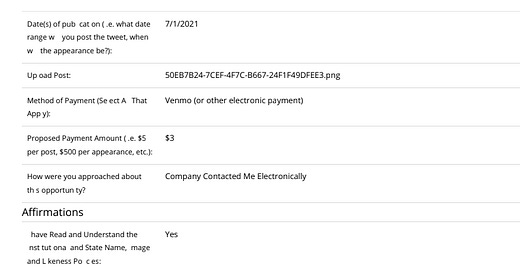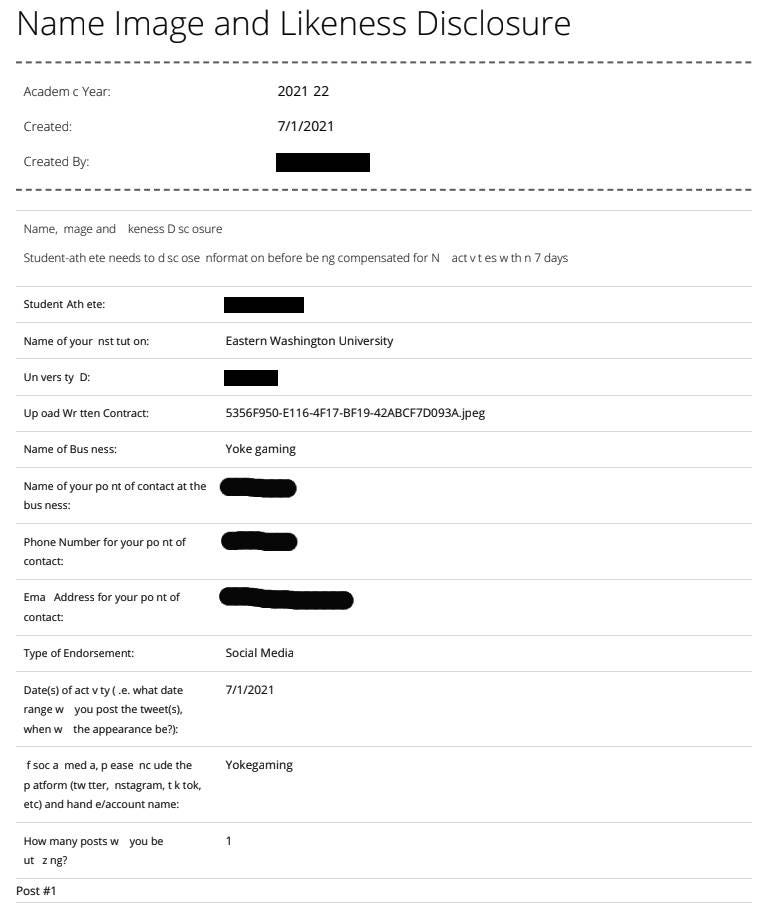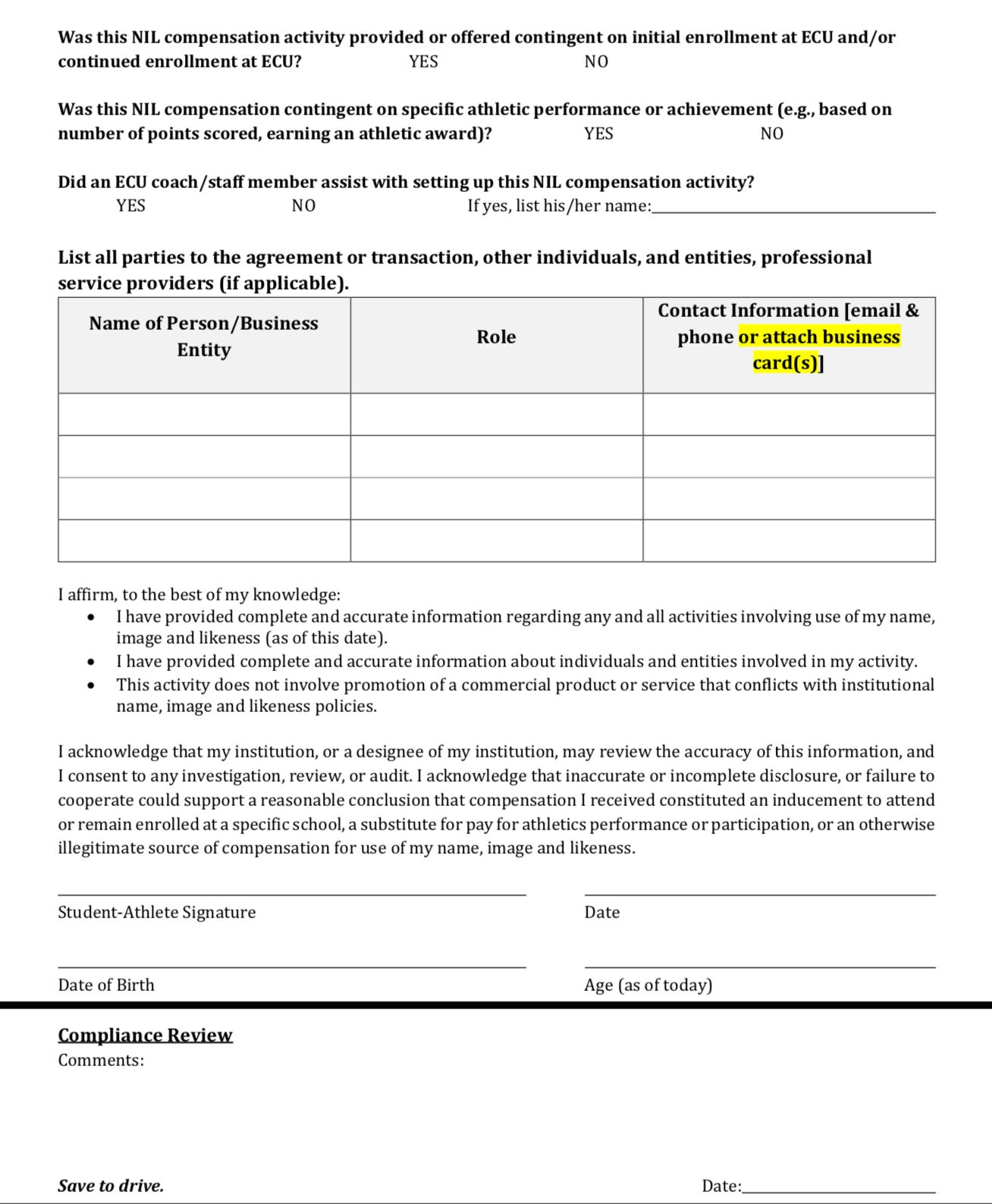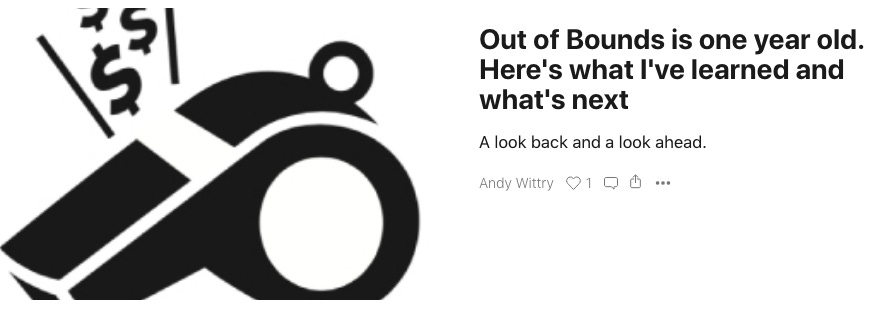I tried to FOIA NIL disclosure forms. Here's what I learned
Eight percent of athlete respondents at one school with a mid-major basketball program said they were involved in NIL activities on July 1.
Welcome back to Out of Bounds, a free, weekly newsletter about college athletics. Feedback, tips and story ideas are always welcome at andrew [dot] wittry [at] gmail [dot] com or you can connect with me on Twitter.
If you’re not yet a subscriber, you can subscribe for free below.
As someone who has filed a Freedom of Information Act (FOIA) request or two, I wondered: What happens when the NIL era of college athletics is finally here and you submit FOIA requests for copies of any name, image and likeness (NIL) disclosure forms submitted to universities on the first day of the NIL era, July 1, 2021?
Is that information, or at least the portions of it that may not be protected by law, considered public record? I was curious and I wasn’t sure, and it turns out that several universities weren’t sure either – at least not initially.
“We did have a couple yesterday,” Louisiana Tech University Legal Counsel Justin Kavalir responded in an email on July 2. “Stand by while I determine what is/is not public record.”
Four days later, Kavalir had the answer:
“Upon further review, these documents fit within the definition of an ‘education record’ for purposes of the Family Educational Rights and Privacy Act (‘FERPA’) and are not subject to disclosure under the Louisiana Public Records Act.”
After first checking with their respective attorneys, representatives from East Carolina University and the University of Iowa eventually reached the same conclusion.
Hey, isn’t that kind of intrusive anyway?
In each of my public records requests, I asked for copies of any NIL disclosure or compliance forms submitted on July 1 – with the necessary redactions, in order to comply with state and federal laws.
Public universities aren’t shy about citing laws such as FERPA or the Health Insurance Portability and Accountability Act (HIPAA) when responding to public records requests, even in some cases where those laws may not necessarily apply. In the case of athletes at universities making money from their NIL rights for the first time ever, within the scope of recently adopted state laws and the NCAA’s interim NIL policy, universities certainly weren’t going to be shy about their application of FERPA.
So I went into this process knowing there was a pretty good chance I wouldn’t obtain much, if any, meaningful information about NIL deals through public records requests. There’s no circumstance in which a university would provide information that athlete X signed an endorsement deal with company Y for $Z – and universities shouldn’t. But if there were any potentially responsive (and redacted) documents, maybe they could provide the public, including college athletes themselves, with an insightful, non-athlete part of that equation, without breaking any laws or invading anyone’s privacy.
Plus, I was genuinely curious about the level of detail that athletes are required to report on their disclosure and compliance forms, and how that level of detail might vary from school to school or from state to state.
Redacted disclosure forms could protect the identities of athletes while potentially making available the terms or forms of compensation, or other contract details. Are some athletes offered compensation in the form of product rather than in U.S. dollars? Are any offered crypto? Is there a chance that high-profile athletes could negotiate stock options as part of their deals?
This was one attempt to find out.
I’ve pored over countless men’s basketball game contracts and coaches’ contracts in order to geek out over the relative minutiae – the force majeure clauses in game contracts and the country club clauses in coaches’ contracts – so why not attempt to do the same with the NIL activities for [redacted athletes]?
These schools had athletes report NIL activities on July 1
Most – but not all – of my public records requests either came up empty or were denied, and those were the two types of rejection emails I received: 1) there are no responsive records, or 2) the responsive records are protected. As someone who knows his way around a public records request, I interpreted the first type of response in this scenario as that no athletes at a given university submitted any NIL disclosure or compliance forms on July 1, and that the latter response indicated that those forms do exist but that the university isn’t disclosing them because they’re protected by law.
Following that train of thought, among the 35 universities that have responded to my public records requests at the time of publishing, 24 universities, or more than 68 percent, indicated they didn’t receive any NIL disclosure or compliance forms on July 1. Disclosure laws and rules can vary by state and university.
Eleven universities did receive disclosure forms on July 1, however, including East Carolina, Florida Atlantic, Indiana, Iowa, Iowa State, Louisiana Tech, Nebraska and Northern Iowa, each of which said the requested documents are protected by FERPA or a similar statute. A blank copy of East Carolina’s disclosure form is available at the bottom of the newsletter.
A representative from Western Illinois informed me that the university received NIL disclosure forms on July 1. So did Eastern Washington and New Mexico State.
Below is a redacted copy of a disclosure form submitted by an athlete at Eastern Washington, who informed the university that the “company (YOKE Gaming) contacted me electronically” in regards to the app that’s designed to allow fans to play video games with athletes. The proposed payment amount from YOKE Gaming for one social media endorsement from the athlete was $3, paid through Venmo or another electronic payment service.
Among the nearly three dozen universities that have responded at the time of publishing, this is the only completed disclosure form I obtained that included any specific details of an NIL activity, such as the potential sponsoring company or the amount of compensation.
I made additional redactions to the document to protect YOKE Gaming’s point of contact’s contact information.
Eight percent of New Mexico State respondents were involved in NIL activities on July 1
New Mexico State University provided Out of Bounds with 51 copies of its NIL disclosure form, which provided athletes with one of three options to check:
“I am not currently engaging in any name, image and likeness activities” (38 athletes)
“I currently am engaging in name, image and likeness activities” (four athletes)
“I intend to engage in name, image and likeness activities” (nine athletes)
The names of the athletes are redacted.
New Mexico State is an FBS independent in football, so while it’ll play schools like Alabama and Kentucky this fall, it operates on a different plane within the NCAA’s Division I populace in terms of revenue and fan interest compared to the Crimson Tide and Wildcats. And yet, 7.8 percent of the respondents – four out of the 51 New Mexico State athletes who filled out a disclosure form – said that as of July 1, they are engaged in NIL activities. If you include the aspirational Aggies who indicated that they intend on engaging in NIL activities, that figure grows to 25.5 percent.
In the months and years prior to the start of the NIL era of college athletics, there were predictions that only one or two percent of college athletes would have any earning potential through their NIL rights. The admittedly limited data from New Mexico State suggests those predictions are potentially wrong – and potentially by a significant number of percentage points – and that’s an encouraging sign for athletes at other similarly sized universities, let alone those at Power 5 or Group of Five institutions.
New Mexico was one of the states that had a state law related to athlete compensation that took effect on July 1 and New Mexico State’s athletic department has been creative with its involvement in the licensed consumables space, so perhaps the Aggies’ athletes were better positioned than most of their peers to hit the ground running with NIL activities at the start of July. But it’s also a school whose football program went 1-1 during the spring season and whose men’s basketball program finished last season ranked No. 150 on kenpom.com, or roughly at the 42nd percentile nationally, which means there are a lot more Division I institutions whose athletic departments are on a similar level as New Mexico State as there are schools with athletic departments that are on par with Alabama and Kentucky.
And athletes at those schools have marketability and earning potential, too.
OK, so what does it mean that people like you can’t really be nosy through public records requests?
If the details of NIL deals typically won’t be publicly available – which is alright! I’d argue more good could come from protecting that information than from releasing it – then you should consume the reporting of the details of any NIL deals with some level of caution and skepticism.
First, is the information even accurate?
If so, who released it and what does that individual stand to gain from its release?
It seems generally unlikely that an athlete would disclose the specific monetary details of an endorsement deal himself or herself, so was it a marketing agent looking to make a splash with additional clients? Was it a disgruntled relative, coach or teammate? Was it someone from the sponsoring company, hoping to earn some goodwill with the local fan base by showing just how committed the company is to supporting the school’s athletes?
Any self-respecting employee of a third-party company that provides NIL-related services to an athletic department isn’t going to disclose the specific details of a given endorsement deal for public consumption. The same goes for compliance officers within athletic departments.
From a media perspective, July 1 was the date that would hopefully mark the end of months of speculative and theoretical coverage about NIL. There are now real rules in place that allow for real endorsements and real business opportunities that provide athletes with real compensation.
But the contracts and the clauses involved will generally be off-limits to the public.
And that’s alright.
East Carolina’s NIL disclosure form
In case you missed the last newsletter
(Click the image below to read)
Read the full newsletter here.
Thank you for reading this edition of Out of Bounds with Andy Wittry. If you enjoyed it, please consider sharing it on social media or sending it to a friend or colleague. Questions, comments and feedback are welcome at andrew.wittry@gmail.com or on Twitter.










